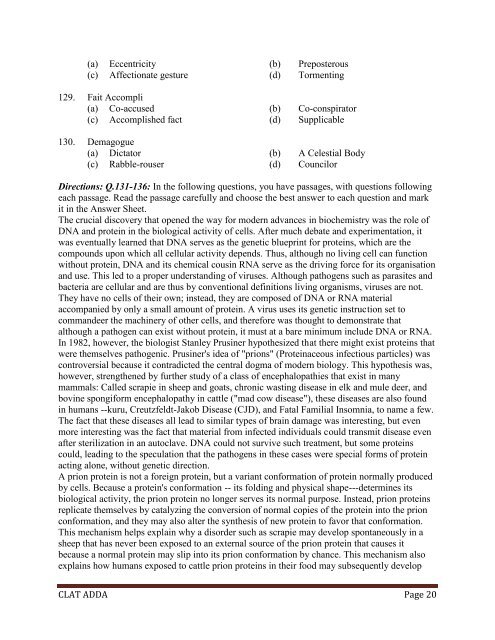NALSAR University of Law, Hyderabad ENTRANCE TEST PAPER ...
NALSAR University of Law, Hyderabad ENTRANCE TEST PAPER ...
NALSAR University of Law, Hyderabad ENTRANCE TEST PAPER ...
You also want an ePaper? Increase the reach of your titles
YUMPU automatically turns print PDFs into web optimized ePapers that Google loves.
(a) Eccentricity (b) Preposterous<br />
(c) Affectionate gesture (d) Tormenting<br />
129. Fait Accompli<br />
(a) Co-accused (b) Co-conspirator<br />
(c) Accomplished fact (d) Supplicable<br />
130. Demagogue<br />
(a) Dictator (b) A Celestial Body<br />
(c) Rabble-rouser (d) Councilor<br />
Directions: Q.131-136: In the following questions, you have passages, with questions following<br />
each passage. Read the passage carefully and choose the best answer to each question and mark<br />
it in the Answer Sheet.<br />
The crucial discovery that opened the way for modern advances in biochemistry was the role <strong>of</strong><br />
DNA and protein in the biological activity <strong>of</strong> cells. After much debate and experimentation, it<br />
was eventually learned that DNA serves as the genetic blueprint for proteins, which are the<br />
compounds upon which all cellular activity depends. Thus, although no living cell can function<br />
without protein, DNA and its chemical cousin RNA serve as the driving force for its organisation<br />
and use. This led to a proper understanding <strong>of</strong> viruses. Although pathogens such as parasites and<br />
bacteria are cellular and are thus by conventional definitions living organisms, viruses are not.<br />
They have no cells <strong>of</strong> their own; instead, they are composed <strong>of</strong> DNA or RNA material<br />
accompanied by only a small amount <strong>of</strong> protein. A virus uses its genetic instruction set to<br />
commandeer the machinery <strong>of</strong> other cells, and therefore was thought to demonstrate that<br />
although a pathogen can exist without protein, it must at a bare minimum include DNA or RNA.<br />
In 1982, however, the biologist Stanley Prusiner hypothesized that there might exist proteins that<br />
were themselves pathogenic. Prusiner's idea <strong>of</strong> "prions" (Proteinaceous infectious particles) was<br />
controversial because it contradicted the central dogma <strong>of</strong> modern biology. This hypothesis was,<br />
however, strengthened by further study <strong>of</strong> a class <strong>of</strong> encephalopathies that exist in many<br />
mammals: Called scrapie in sheep and goats, chronic wasting disease in elk and mule deer, and<br />
bovine spongiform encephalopathy in cattle ("mad cow disease"), these diseases are also found<br />
in humans --kuru, Creutzfeldt-Jakob Disease (CJD), and Fatal Familial Insomnia, to name a few.<br />
The fact that these diseases all lead to similar types <strong>of</strong> brain damage was interesting, but even<br />
more interesting was the fact that material from infected individuals could transmit disease even<br />
after sterilization in an autoclave. DNA could not survive such treatment, but some proteins<br />
could, leading to the speculation that the pathogens in these cases were special forms <strong>of</strong> protein<br />
acting alone, without genetic direction.<br />
A prion protein is not a foreign protein, but a variant conformation <strong>of</strong> protein normally produced<br />
by cells. Because a protein's conformation -- its folding and physical shape---determines its<br />
biological activity, the prion protein no longer serves its normal purpose. Instead, prion proteins<br />
replicate themselves by catalyzing the conversion <strong>of</strong> normal copies <strong>of</strong> the protein into the prion<br />
conformation, and they may also alter the synthesis <strong>of</strong> new protein to favor that conformation.<br />
This mechanism helps explain why a disorder such as scrapie may develop spontaneously in a<br />
sheep that has never been exposed to an external source <strong>of</strong> the prion protein that causes it<br />
because a normal protein may slip into its prion conformation by chance. This mechanism also<br />
explains how humans exposed to cattle prion proteins in their food may subsequently develop<br />
CLAT ADDA Page 20


